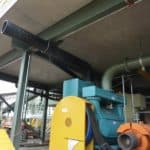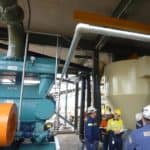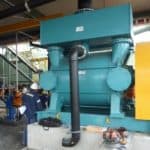Client
We assisted a Hunter Valley coal mine operator with their coal preparation plant (CPP).
Challenge
Operators of the CPP were concerned about the acoustic impact of a vacuum pump on the surrounding work environment and the noise exposure of workers in the area. Site personnel had reported high levels of noise emanating from the vacuum pump since recent modifications.
Recognising Advitech Environmental’s experience in vibration, acoustics and engineering, we were engaged to undertake an acoustic assessment at the site and recommend vibro-acoustic engineering solutions to reduce machine emissions to an acceptable level.
Solution
The project involved an initial acoustic assessment to understand the noise problem, followed by the design of a new exhaust system to attenuate the noise emanating from the vacuum pump.
Acoustic assessment
Advitech’s acoustics specialists undertook an acoustic assessment in accordance with the WHS Regulation 2011, Chapter 4 Hazardous Work, Part 4.1 Noise.
The client provided detailed information relating to the operation of equipment within the CPP. The assessment looked at the relationship between vacuum pump operating speeds and acoustic frequencies, allowing for narrow band airborne noise contributions to be matched to particular machines.
Audible noise sources detected during the assessment included a discrete tone emanating from the vacuum pump and the continual hum of the CPP operations. During the monitoring period, the pump noise displayed both tonal and impulsive acoustic modes of operation.
Advitech recommended that an engineered noise control solution was required to reduce the acoustic impact to an acceptable level. This would involve the design of a custom muffler to be installed within the exhaust pipe system.
Design of a new exhaust system
Our acoustic specialists teamed up with Advitech’s structural engineers to design the replacement exhaust system. Our engineering team was ideally placed to complete the design as they had the knowledge and insight necessary to consider all aspects of the project including the acoustic properties of both air borne and structural borne noise emissions.
The existing polyethylene exhaust pipe was modelled in the Strand7 finite element analysis software, based on the manufacturers specifications. The Youngs modulus of the material was noted to change with temperature, so a conservative value was adopted.
The Strand7 natural frequency solver was used, finding several vibrational modes present in the exhaust around the blade pass frequency for the vacuum pump fan. These vibrational modes were predominantly associated with the development of standing waves radially along the exhaust pipe. The vibrational modes could be excited by vibrations from unbalanced loads within the fan or pressure fluctuations (noise) from the pump. The resonance of the exhaust pipe would result in displacement and pressure variations of the air surrounding the exhaust pipe. The pressure variations emanating from the exhaust pipe are effectively another noise source on top of what was already emanating from the vacuum pump.
A second model was prepared with similar overall geometry, but using steel pipe instead of polyethylene. Natural frequency analysis on the steel exhaust found the frequencies of the vibrational modes were much higher thanks to the increased stiffness of the material. No vibrational modes were identified near to the pump fan blade pass frequency, limiting any potential resonance. Additionally, the vibrational mode nearest to the fan blade pass frequency was associated with a rotational mode within the pipe. Excitation of this rotational mode would not result in any additional air movement and pressure fluctuations (noise) emanating from the exhaust.
As a result of the analysis, Advitech recommended replacement of the polyethylene pipe with a steel pipe. From a vibro-acoustic perspective, the Advitech team was able to model and engineer a new exhaust system (comprising a retro-fitted muffler unit and tuned steel pipe exhaust) that could achieve a satisfactory reduction in noise emissions – for a significantly reduced cost compared to other noise mitigation options.
Outcome
The new exhaust system was manufactured and installed according to Advitech’s design. A noise survey conducted after installation demonstrated a reduction in noise emissions and occupational exposure of approximately 8dB(A). Prior to installation, the vacuum pump produced noise in the range 93 to 97 dB(A). After noise control treatment, noise emissions decreased to 85 to 89 dB(A).
By choosing Advitech, the mine operator benefited from the combined forces of our acoustics and structural engineering specialists, engaging just one organisation to achieve a complete solution from assessment through to the delivery of a successful result.




